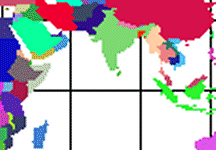Question Sheet: Wave of Destruction
SCIENCE
Before reading:
- What are some of the natural dangers that people living near the ocean could face?
- Why do many people live close to the water?
- Could there be a tsunami where you live? Why or why not?
During reading:
- What causes a tsunami?
- What may be the hardest part in predicting tsunamis?
- Where did the recent Indian Ocean quake take place?
- Describe the warning signs that indicate a tsunami might strike.
- How might Dalrymple’s use of mathematics help reduce tsunami damage?
- Besides the destruction caused by a tsunami, what other effects could such a disaster cause? Name at least three that could create great concern among people.
After reading:
- When scientists detect that a tsunami is coming, what do you think would be the best way to warn people? What do you think would make a good warning system?
- How would a warning system for tsunamis be different from a warning system for hurricanes or tornadoes?
- Come up with an idea for raising money for tsunami victims.
- What sorts of researchers would study tsunamis? Come up with at least two different types of scientists or engineers who might be interested in the phenomenon.
- Design and draw a picture of a house that you think would be safe in a tsunami. Be sure to label all the parts. Given that many of the people whose homes were destroyed have little money, how might you make this house affordable for these people?
- Why is it difficult to predict where a tsunami wave will break?
SOCIAL STUDIES
- Where are the Maldives? For information about the Maldives, see en.wikipedia.org/wiki/Maldives(Wikipedia). The Maldives hold the record for being the flattest country in the world, with a maximum altitude of only 2.3 meters above sea level. What dangers does such a low-lying country face? How was it affected by the recent Indian Ocean tsunami?
- On the map below, show the location of the following countries: Indonesia,bMalaysia, Thailand, Sri Lanka, India, Bangladesh, Somalia, Myanmar, and Kenya. What is the capital of each of these countries?
 |
LANGUAGE ARTS
- Many children were affected by the Indian Ocean tsunami in many different ways. Write a letter to a kid of your own age in Thailand who might have been affected by the tsunami. What would you ask him or her? What could you offer to do?
- Find three different newspaper articles on the tsunami disaster. Compare the articles. How do the writers present the same information in different ways?
MATHEMATICS
Due to the distances involved, the Indian Ocean tsunamis took anywhere from 15 minutes to 7 hours (for Somalia) to reach the various coastlines. On average, how fast did the tsunami travel if the distance from the earthquake’s location near Indonesia to Somalia’s coast is about 3,500 miles?